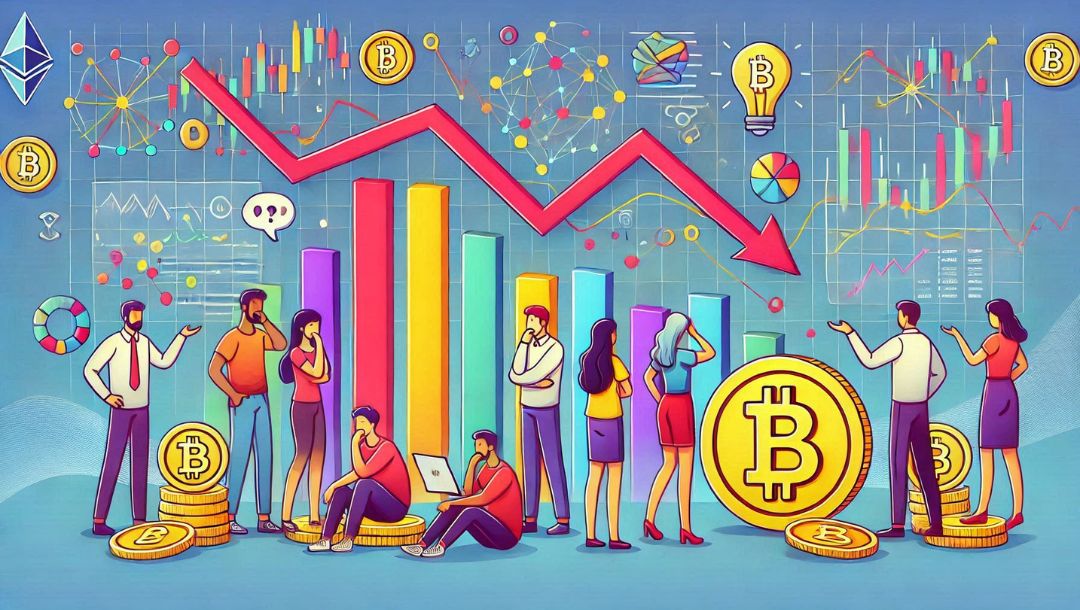Is USA Hawkish Stance Answer to ‘Why Crypto Down Today?’
So, you’re wondering why crypto is down today? Well, a lot of it has to do with the Federal Reserve’s recent moves. They’ve been taking a tough stance, and it’s got everyone in the crypto world a bit on edge. The Fed’s been hinting at keeping interest rates high, and that’s making the dollar stronger. When the dollar goes up, crypto tends to go down. It’s a bit of a seesaw effect. Anyway, let’s break down the key points.
Key Takeaways
- The Federal Reserve’s hawkish stance is making waves in the crypto market, causing prices to drop.
- Interest rate projections are crucial. When rates are expected to stay high, crypto often takes a hit.
- A strong U.S. dollar isn’t great news for crypto. As the dollar strengthens, crypto valuations tend to fall.
- Investor sentiment is shaky with the Fed’s policies, leading to increased volatility in crypto markets.
- External economic indicators, like inflation and employment rates, also play a role in crypto’s current downturn.
The Federal Reserve’s Hawkish Stance and Its Impact on Crypto
Understanding the Fed’s Recent Announcements
The Federal Reserve recently made waves with its decision to cut rates by 25 basis points, a move that, while anticipated, came with a twist. Fed Chair Jerome Powell’s comments hinted at a slower pace of future rate reductions, signaling a hawkish stance that caught many off guard. This shift indicates that interest rates might remain higher for longer than previously expected, prompting a ripple of reactions across various markets.
How Interest Rate Projections Affect Crypto Markets
Interest rates are a big deal for crypto investors. When the Fed talks about keeping rates high, it often means the U.S. dollar strengthens. A strong dollar can make cryptocurrencies less attractive since they are priced against it.
- Higher rates: Increase the appeal of the dollar, reducing the allure of riskier assets like crypto.
- Market expectations: If the Fed signals fewer cuts, it can lead to a sell-off in crypto as traders adjust their strategies.
- Investor sentiment: Uncertainty about future rates can lead to volatility, impacting crypto prices negatively.
The Role of the U.S. Dollar in Crypto Valuations
The U.S. dollar plays a crucial role in determining the value of cryptocurrencies. When the dollar gains strength, as it did following the Fed’s hawkish signals, crypto prices often face downward pressure. This is because a stronger dollar increases the purchasing power of investors holding other currencies, making cryptos relatively more expensive.
The Fed’s hawkish stance not only boosted the dollar but also sent shockwaves through the crypto market, highlighting the sensitive balance between fiat currencies and digital assets.
In summary, the Federal Reserve’s recent actions and comments have set the stage for a challenging environment for cryptocurrencies. As investors navigate these waters, understanding the interplay between interest rates and crypto valuations remains essential.
Market Reactions to Hawkish Fed Policies
Crypto Market’s Immediate Response
When the Fed makes a move, the crypto market doesn’t just sit there. It jumps. The recent hawkish rate cut by the Fed sent shockwaves through the crypto world, causing immediate sell-offs. Traders often react quickly to any changes in interest rates, as these can affect liquidity and borrowing costs. As a result, Bitcoin and other major cryptocurrencies saw significant drops in value almost overnight.
Crypto markets are incredibly sensitive to monetary policy changes, reacting swiftly to any perceived threats to liquidity.
Long-term Implications for Digital Assets
The long-term picture is a bit more complex. While immediate reactions can be severe, the broader impact depends on several factors:
- Investor Confidence: If investors believe the Fed will continue tightening, they might steer clear of riskier assets like crypto.
- Market Adaptation: Over time, markets often adjust to new interest rate environments, which could stabilize crypto prices.
- Regulatory Changes: Any new regulations in response to Fed policies can either support or hinder crypto growth.
Comparing Crypto and Traditional Market Reactions
Crypto isn’t the only market feeling the heat from the Fed’s hawkish stance. Traditional markets like stocks and bonds also react, but usually in different ways:
- Stocks: Often see a decline as higher interest rates can lead to higher borrowing costs for companies, potentially slowing growth.
- Bonds: Generally, bond prices fall as interest rates rise, but yields increase, attracting different types of investors.
- Cryptocurrencies: The volatility is typically higher, with prices swinging more dramatically in response to changes.
In the end, while both markets react to Fed policies, the crypto market tends to do so with more volatility and unpredictability. This divergence can be attributed to the relatively nascent nature of digital assets compared to well-established traditional markets.
Why Is Crypto Down Today? Analyzing Key Factors
The Influence of Federal Reserve Policies
The Federal Reserve’s recent decisions have certainly shaken things up in the crypto world. With their hawkish stance, indicating that interest rates might stay high for longer, investors are understandably jittery. Higher interest rates generally mean a stronger dollar, which can make cryptocurrencies less attractive as they are often seen as alternative assets. This shift has led to a noticeable dip in crypto prices, with Bitcoin dropping below $93,100.
Investor Sentiment and Market Volatility
Investor sentiment is a huge driver in the crypto market. When there’s uncertainty, like with the Fed’s announcements, people tend to pull back. This retreat can lead to increased volatility, causing wild price swings. Some investors might sell off their holdings, further driving prices down. It’s a bit of a vicious cycle—uncertainty leads to selling, which leads to more uncertainty.
External Economic Indicators Impacting Crypto
Aside from the Fed’s influence, other economic indicators also play a role. Factors such as inflation forecasts, employment rates, and global economic conditions can all affect crypto prices. For instance, a weaker-than-expected inflation forecast for 2025 has dampened optimism, contributing to the current downturn. Additionally, specific events like XRP’s recent decline due to selling pressure and liquidations have also impacted the market, showing how interconnected these factors can be.
The crypto market is like a rollercoaster, heavily influenced by both internal dynamics and external economic factors. Staying informed and adaptable is key for anyone navigating these turbulent waters.
The Ripple Effect: How Fed Policies Affect Major Cryptocurrencies
Bitcoin’s Price Movements Post-Fed Announcements
Bitcoin’s price often reacts sharply to the Federal Reserve’s announcements. When the Fed hints at keeping interest rates high, Bitcoin tends to dip. For instance, after recent hawkish comments, Bitcoin slipped below $93,100, continuing its downward trend. This happens because investors see fewer rate cuts, which dampens optimism.
Ethereum and Solana: Case Studies
Ethereum and Solana, two giants in the blockchain world, also feel the heat from the Fed’s stance. Ethereum’s price has been relatively stable, but Solana took a hit after the Fed’s latest guidance. The Fed’s policies can shake up these markets, especially when they signal tighter monetary policy.
Meme Coins and Their Volatility
Meme coins, like Dogecoin and Shiba Inu, are super sensitive to market vibes. When the Fed goes hawkish, these coins often see wild swings. Recently, after a Fed meeting, meme coins experienced steep losses, showing how quickly sentiment can shift in this space.
The Fed’s decisions ripple through the crypto world, impacting everything from Bitcoin to meme coins. Investors need to stay alert to these shifts, as they can change the landscape overnight.
Navigating the Crypto Market Amidst Hawkish Fed Signals
Strategies for Crypto Investors
When the Federal Reserve drops hawkish hints, crypto investors need to be nimble. Staying informed about Fed announcements is key. It’s like keeping your ear to the ground for the first sign of a storm. Here are some strategies to consider:
- Diversify Holdings: Don’t put all your eggs in one basket. Spread investments across different types of cryptocurrencies to reduce risk.
- Monitor Market Trends: Keep an eye on how major cryptocurrencies like Bitcoin and Ethereum react to Fed signals. This can offer clues about broader market sentiment.
- Set Stop-Loss Orders: Protect your investments by setting stop-loss orders to automatically sell assets if they fall below a certain price.
Risk Management in Volatile Markets
Volatility is a given in the crypto space, especially when the Fed is in a hawkish mood. To manage risks, consider the following:
- Stay Liquid: Maintain a portion of your portfolio in cash or stablecoins to capitalize on sudden market opportunities.
- Limit Leverage: Avoid using excessive leverage which can amplify losses during downturns.
- Regular Portfolio Review: Frequently reassess your portfolio to ensure it aligns with your risk tolerance and market conditions.
In times of uncertainty, flexibility is your best ally. Adjust your strategies as new information comes in, and don’t be afraid to pivot when necessary.
Opportunities in a Bearish Crypto Environment
Even in a bearish market, opportunities exist. It’s about spotting them before they become obvious:
- Look for Undervalued Assets: Bear markets can offer buying opportunities for undervalued cryptocurrencies.
- Focus on Fundamentals: Invest in projects with strong fundamentals that are likely to weather the storm.
- Consider Staking and Yield Farming: These can provide passive income even when prices are down.
Navigating the crypto market during hawkish Fed signals requires a mix of caution and opportunism. By staying informed and flexible, investors can not only protect their portfolios but also find new avenues for growth.
The Future of Crypto in a Hawkish Economic Climate
Predictions for 2025 and Beyond
As we look towards 2025, the crypto landscape is expected to evolve significantly, influenced by the Federal Reserve’s hawkish stance. Many analysts predict that interest rates will remain elevated, which could suppress the growth of speculative assets like cryptocurrencies. However, this environment could also drive innovation and adoption of blockchain technologies as projects seek to demonstrate tangible value beyond mere speculation.
Potential Policy Shifts and Their Impacts
Potential shifts in monetary policy could dramatically alter the crypto market’s dynamics. If the Fed decides to ease its hawkish policies, we might see a resurgence in crypto investments. Conversely, continued tight monetary policies could lead to prolonged bearish trends. Investors will need to stay informed about key factors that influence these policy decisions and their subsequent effects on the market.
The Role of Institutional Investors
Institutional investors are likely to play a pivotal role in the future of crypto. Their involvement brings a level of stability and legitimacy to the market. As these investors navigate the challenges of a hawkish economic climate, their strategies will be crucial in determining the market’s direction. They are expected to focus on assets with clear use cases and regulatory compliance.
Despite the challenges posed by a hawkish Fed, the crypto market’s resilience and adaptability could pave the way for new opportunities and growth in the coming years.
Conclusion
So, is the USA’s hawkish stance the reason behind crypto’s recent dip? Well, it sure seems like it. The Federal Reserve’s tough talk about keeping interest rates high has made the dollar more attractive, pulling investors away from riskier assets like cryptocurrencies. This isn’t the first time we’ve seen such a reaction, and it probably won’t be the last. As the Fed continues to signal a cautious approach, the crypto market might keep feeling the heat. But who knows? The crypto world is unpredictable, and things could change in a blink. For now, though, it looks like the Fed’s stance is a big piece of the puzzle when it comes to understanding why crypto is down today.
Frequently Asked Questions
What does it mean when the Federal Reserve is hawkish?
When the Federal Reserve is hawkish, it means they are likely to raise interest rates to control inflation. This can make borrowing more expensive and can impact investments like cryptocurrencies.
Why does a strong U.S. dollar affect cryptocurrency prices?
A strong U.S. dollar can make cryptocurrencies less appealing because it means people can buy less with their crypto compared to the dollar. This can lead to lower demand and falling prices.
How do interest rates impact the crypto market?
Higher interest rates can lead to a decrease in crypto investments because they make traditional savings more attractive. People might choose to save money instead of investing in riskier assets like cryptocurrencies.
What happened to Bitcoin after the Fed’s recent announcement?
After the Fed’s recent announcement, Bitcoin’s price fell as investors reacted to the news of potential interest rate hikes and a strong dollar, which can reduce the appeal of investing in cryptocurrencies.
Are meme coins affected differently by Fed policies?
Yes, meme coins, which are often more volatile and less stable, can be more heavily impacted by Fed policies. They might see sharper price drops compared to more established cryptocurrencies like Bitcoin or Ethereum.
What can crypto investors do during a bearish market?
During a bearish market, crypto investors can focus on long-term strategies, diversify their investments, and manage risks carefully. It’s important to stay informed about market trends and economic signals.
Stay informed with daily updates from Blockchain Magazine on Google News. Click here to follow us and mark as favorite: [Blockchain Magazine on Google News].
Get Blockchain Insights In Inbox
Stay ahead of the curve with expert analysis and market updates.
latest from tech
Disclaimer: Any post shared by a third-party agency are sponsored and Blockchain Magazine has no views on any such posts. The views and opinions expressed in this post are those of the clients and do not necessarily reflect the official policy or position of Blockchain Magazine. The information provided in this post is for informational purposes only and should not be considered as financial, investment, or professional advice. Blockchain Magazine does not endorse or promote any specific products, services, or companies mentioned in this posts. Readers are encouraged to conduct their own research and consult with a qualified professional before making any financial decisions. The featured image used is just a creative depiction of the title and it does not intend to hurt sentiments of any person or institution. If it hurts anyone sentiments, please do not hesitate to reach out to Blockchain Magazine.

 Bitcoin
Bitcoin  Ethereum
Ethereum  XRP
XRP  Tether
Tether  Solana
Solana  USDC
USDC  Dogecoin
Dogecoin  Cardano
Cardano  Lido Staked Ether
Lido Staked Ether  TRON
TRON  Wrapped Bitcoin
Wrapped Bitcoin  Wrapped stETH
Wrapped stETH  Chainlink
Chainlink  Avalanche
Avalanche  Sui
Sui  Stellar
Stellar  Litecoin
Litecoin  Toncoin
Toncoin  Shiba Inu
Shiba Inu  Hedera
Hedera  LEO Token
LEO Token  USDS
USDS  Hyperliquid
Hyperliquid  WETH
WETH  Polkadot
Polkadot  MANTRA
MANTRA  Bitcoin Cash
Bitcoin Cash  Bitget Token
Bitget Token  Ethena USDe
Ethena USDe  Wrapped eETH
Wrapped eETH  Uniswap
Uniswap  Monero
Monero  NEAR Protocol
NEAR Protocol  Pepe
Pepe  WhiteBIT Coin
WhiteBIT Coin  Aave
Aave  Ondo
Ondo  Bittensor
Bittensor  Aptos
Aptos  Internet Computer
Internet Computer  Dai
Dai  Official Trump
Official Trump  Mantle
Mantle  Ethereum Classic
Ethereum Classic  Tokenize Xchange
Tokenize Xchange  OKB
OKB  Gate
Gate  sUSDS
sUSDS  Coinbase Wrapped BTC
Coinbase Wrapped BTC 




